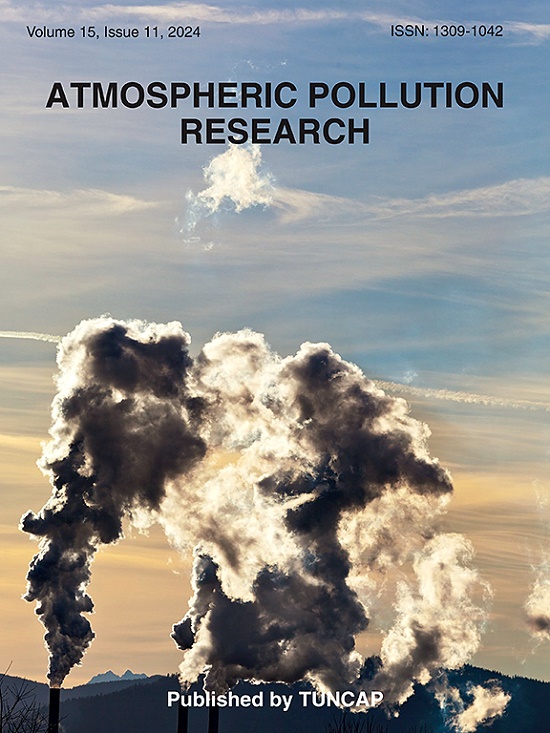Unveiling the source contributions of fine and coarse particulate matter using PM-bound metals and PMF-AI modeling
IF 3.9
3区 环境科学与生态学
Q2 ENVIRONMENTAL SCIENCES
引用次数: 0
Abstract
Particle pollution is a critical global concern with significant implications for public health and the environment. Both fine (PM2.5) and coarse (PM2.5-10) particles exhibit diverse compositions and origins, leading to distinct health and environmental consequences. In this study, K-means clustering was employed to differentiate between local, regional, and long-range transport (LRT) sources, showing that LRT significantly increases PM2.5-10 levels, leading to a more than 1.26-fold rise in its annual mean concentration. Using Positive Matrix Factorization (PMF) model, we identified five local and regional source of PM2.5 and four in case of PM2.5-10. Further, AutoML model explains up to 70 % and 71 % of the daily variance in PM2.5 and PM2.5-10, respectively. The complex relationship of these sources was explained using SHapley Additive ExPlanations (SHAP). Among the five major factors identified, SHAP analysis reveals that oil combustion (24 %), coal burning (18 %), and non-ferrous metal smelting/biomass burning (17 %) are the predominant contributors to PM2.5. In contrast, ocean spray (28 %) is identified as a significant source of PM2.5-10 pollution followed by oil, non-ferrous metal smelting/biomass burning (20 %) and traffic related emission (14 %). This study offers a novel and comprehensive methodology for identifying the distinct sources of fine and coarse particulate matter. It provides valuable insights that can inform future policies and regulations, particularly in regions facing challenges related to PM pollution.

利用与可吸入颗粒物结合的金属和 PMF-AI 模型揭示细颗粒物和粗颗粒物的来源贡献
颗粒物污染是全球关注的一个重要问题,对公众健康和环境有重大影响。细颗粒物(PM2.5)和粗颗粒物(PM2.5-10)的组成和来源各不相同,对健康和环境造成了不同的影响。本研究采用 K 均值聚类来区分本地、区域和长程飘移(LRT)来源,结果表明长程飘移会显著增加 PM2.5-10 的浓度水平,导致其年均浓度上升 1.26 倍以上。利用正矩阵因式分解(PMF)模型,我们确定了 PM2.5 的五个本地和区域来源,以及 PM2.5-10 的四个来源。此外,AutoML 模型分别解释了 PM2.5 和 PM2.5-10 高达 70% 和 71% 的日差异。使用 SHapley Additive ExPlanations(SHAP)解释了这些来源的复杂关系。在确定的五个主要因素中,SHAP 分析表明,石油燃烧(24%)、煤炭燃烧(18%)和有色金属冶炼/生物质燃烧(17%)是 PM2.5 的主要来源。相比之下,海洋喷雾(28%)被确定为 PM2.5-10 的重要污染源,其次是石油、有色金属冶炼/生物质燃烧(20%)和交通相关排放(14%)。这项研究为确定细颗粒物和粗颗粒物的不同来源提供了一种新颖而全面的方法。它提供了宝贵的见解,可为未来的政策和法规提供依据,尤其是在面临可吸入颗粒物污染挑战的地区。
本文章由计算机程序翻译,如有差异,请以英文原文为准。
求助全文
约1分钟内获得全文
求助全文
来源期刊

Atmospheric Pollution Research
ENVIRONMENTAL SCIENCES-
CiteScore
8.30
自引率
6.70%
发文量
256
审稿时长
36 days
期刊介绍:
Atmospheric Pollution Research (APR) is an international journal designed for the publication of articles on air pollution. Papers should present novel experimental results, theory and modeling of air pollution on local, regional, or global scales. Areas covered are research on inorganic, organic, and persistent organic air pollutants, air quality monitoring, air quality management, atmospheric dispersion and transport, air-surface (soil, water, and vegetation) exchange of pollutants, dry and wet deposition, indoor air quality, exposure assessment, health effects, satellite measurements, natural emissions, atmospheric chemistry, greenhouse gases, and effects on climate change.
 求助内容:
求助内容: 应助结果提醒方式:
应助结果提醒方式:


